Shoe tying is a rite of passage for many children. In school, kids are often encouraged to learn to tie their shoes in kindergarten, but that can be a real struggle for many students, developmentally. Shoe tying is an ADL that requires many underlying skill areas that just aren’t developed at 5-6 years old. Here, we’re breaking down shoe tying into activities to promote this functional task, shoe tying crafts, and resources to develop this functional skill. You’ll also find shoe tying styles, tying shoes videos, and more strategies that you can use to help kids develop this functional task. Be sure to also check out this resource on one handed shoe tying.
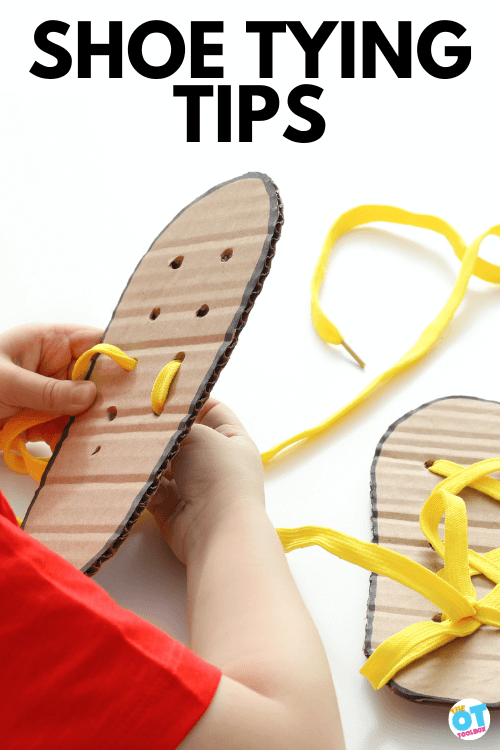
Shoe Tying
If teaching kids to tie their shoes is something that makes you want to give up and buy a pair of Velcro shoes, then you are in the right place. Here, you will find shoe tying resources for the therapist helping kids to work on the skills that go into successful shoe tying. You will find activities to build the underlying skills that kids need to tie their shoes. You will find shoe tying tips. And, you will find activities to make shoe tying practice fun.
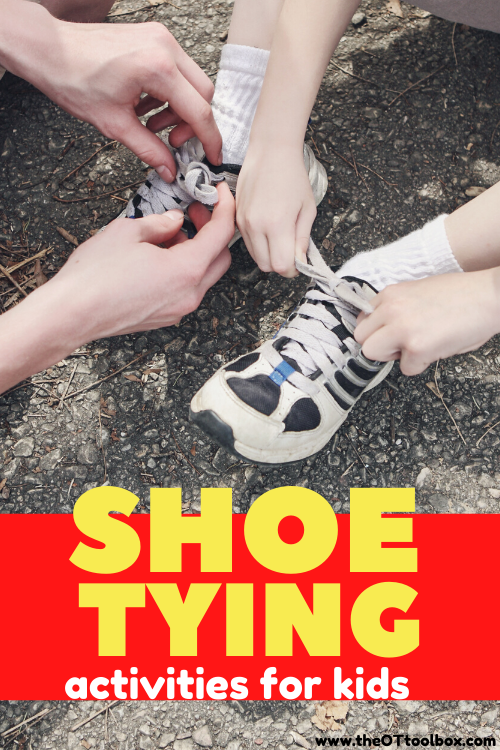
Teaching Kids to Tie Shoes
The thing is that teaching kids to tie shoes is tricky! For some kids, tying shoelaces, is torture. They fumble the laces, make knots, or tie the laces so loosely that the shoes are not laced up.
There is more to it than handing kids a pair of laces and ending up with neatly tied laces. That’s why I wanted to put together this resource on tying shoelaces.
Let’s start by covering various shoe tying methods.
Shoe Tying Methods
Tying shoes can be a struggle for many kids and what works for one child won’t work for another. Luckily there are many shoe tying methods out there.
There are several different shoe tying methods that can work for your child. There are benefits to each of the different ways to tie shoes, and what works for one child may not work best for another child. The important thing is to remain consistent when it comes to teaching a child to tie their shoes.
There are quite a few ways to tie shoelaces! One is not better than the other, it just depends on the child. For each shoe tying methods, a couple things to keep in mind:
- Start practicing with the shoe NOT on the foot. Place it on the table or in the child’s lap. Once the child has mastered tying the laces this way, he can then put the shoe on and practice while wearing it.
- Consider practicing on laces that are thicker/stiffer. These are usually easier to manipulate.
- Consider practicing with 2 different colored laces, tied together at the end and laced into a shoe. This provides visual cues to differentiate the laces. This is especially helpful for kids that mix up their left and right hand, or need more help with directionality. Check out this resource on mixed dominance to get started.
- Some children need to learn this skill gradually. They might need to practice the 1st step over and over before moving to the next step, adding 1 step at a time until they have mastered it.
Traditional Shoe Tying Method:
This is the way most of us learned to tie our shoes. In the video link below, when making the 1st knot, I place the laces in an “X” over the shoe. Sometimes kids hold the laces in both hands and end up getting them twisted together. So this just makes it easier for some kids. For kids that don’t know where to pinch the laces, this is a great strategy. For kids that make one loop too big when tying shoes, this strategy is quite helpful.
You’ll also notice some black lines on the laces. These are placed on there so that when the lines are placed together, they form the 1st loop with the correct size.
Many kids tend to make the 1st loop so large that there is no lace left to finish tying it, so this helps them visualize the loop size.
Two Loop Shoe Tying Method:
This is an adapted method of shoe tying with two loops knotted into the shoe. The child then ties the two loops together two times. The 2 loop shoe tying method is different than the commonly known “bunny ear method”. It has fewer steps, and can be easier for some kids to learn.
- Pull the laces out from the top hole so they do not cross all the way to the top of the shoe.
- With the left lace, thread it back into the top hole on the left side of the shoe.
- Tie a small knot at the end of the lace so it creates a loop on the left side of the shoe.
- With the right lace, thread it back into the top hole on the right side of the shoe.
- Tie a small knot at the end of the lace so it creates a loop on the right side of the shoe.
- Hold both loops and cross one over the other.
- Push one loop under the other to create a criss cross tie.
- Hold both loops and cross one over the other in the other direction.
- Push one loop under the other to create a criss cross tie.
- The shoes are now tightly tied.
Here are some videos that shoe different shoe tying methods:
The Ian Knot (Fast knot method)
Sometimes shoe tying is just so frustrating for a child, due to a variety of reasons, that you might need another way to fasten shoes (without having to keep buying velcro fastening shoes). There are a variety of alternative laces, but my favorite ones are elastic and come in a variety of colors. They have a plastic sliding lock that slides up and down the laces to tighten/loosen them. These are easy and practical and look nice on the shoes.
How to Teach Kids to Tie Shoes
This is your one stop spot for how to teach kids to tie their shoes.
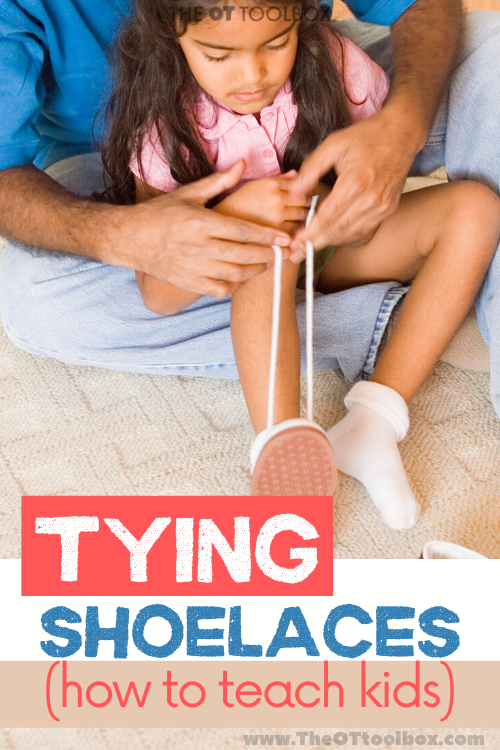
Shoe tying tips
Before starting with shoe tying instruction, it can be helpful to set the child up for success. Try these shoe tying tips and then check out the resources below:
- Chose a shoe tying method and stick with it.
- Use two different colored laces.
- Practice from the child’s point of view. Sit behind the child so your hands are positioned the same as the child’s would be.
- Practice the underlying skills needed for shoe tying in fun ways…Shoe tying crafts and activities are below!
- Use simple terms and one-step directions.
- Try backward chaining- Complete the whole tying shoes process and let the child complete the last steps. This method gives the child a sense of accomplishment. Then, keep adding steps so they are completing more of the task.
- Try forward chaining- Have the child complete the first step and you complete the rest. Then add more steps on so the child learns step-by-step shoe tying.
When shoe tying is hard
Sometimes learning to tie shoes causes meltdowns and tears. That happens! Tying shoes requires many advanced skills. It’s ok to decide to put this skill on hold for a time.
Success TIps with learning to tie shoes
Kids can fall off of shoe tying practice in many ways. Sometimes it is the hard task that they get overwhelmed with or frustrated by. They can try a few times and get overwhelmed by the many steps and then not want to try again. They can try practice out of the task without regular shoes or and not be able to carry that over to actually wearing shoes and tying them. To overcome these pitfalls of shoe tying try the strategies:
- Success Tip number 1- Practice on a daily basis. There needs to be commitment from the child and the parent to put time into practicing this skill.
- Success Tip number 2- Write down your goals.
- Success tip number 3- Use a growth mindset for shoe tying. Teach kids that they can do hard things, and they can try again even if they mess up.
- Success number 4- Teach kids to tell others what they’re working on so that they can feel proud and confident of what they can accomplish.
- Success tip number 5- Work on underlying skill areas. It can be helpful to work on the underlying skills. Check out those skill areas below.
- Success tip number 6- Make practice fun! Use activities and get buy-in from the child to make this task a fun thing to work on…with independence as the benefit!
commit time to practice Shoe tying
Another important concept is to commit to practice. Sometimes we can make a lot of plans and complete activities while multitasking when practicing with intention can be a great strategy for success. And this is a great skill to teach to kids, in which they can carry over to tasks in the school and learning at home.
Teaching kids that they can do hard things offers strategies for sticking to task and other executive functioning skills. Another way to teach kids that they can do hard things with many steps like tying shoes includes creating a step-by-step plan to practice, working through each step of the process, and holding themselves accountable.
We can also have allow kids to make goals for themselves such as if they want to learn to try to shoot their own shoes before the start of the school they can make a goal for themselves with a picture of a shoe and put stickers on the picture each time they practice. You can also create a plan for practice which includes practicing each morning before leaving or walking out the door.
- Try using a practice chart where the child can color in parts of a shoe drawing as they practice each step.
- Or they can put a sticker on a picture each day that they practice. This allows kids to see how much they have work they have put into this hard task of practicing.
One way to work on shoe tying in a functional manner is to get the buy-in and commitment of the child. Unless a child is committed to working on a functional tasks like shoe tying, it can be hard to see progress. This is true for functional tasks and complicated tasks with several steps such as learning to tie shoes.
We know that commitments to activities like no need to tie shoes or learning cursive or changing a pencil grasp requires a desire to complete the task at hand. This is a complicated task for many kids with many steps! In order to drive success with learning to tie shoes you can work on the performance of the task by incorporating interest and commitment to the activity.
When you get commitment to completing the activity like she tying kids can improve their self-confidence and you can see a positive result. This is this occurs because we have a desire of the child to actually complete the activity. When their fully committed shoe tying becomes easier to accomplish because the child will struggle but they have that any desire to actually learn to tie shoes.
Kids can write down their goal or draw a picture of shoes that are tied.
Shoe tying with a growth mindset
For a lot of kids the struggle of shoe trying is this difficult multi-step task where kids try a few times and then get frustrated. You might hear kids say things like: “Tying a shoe is too hard.”, “I can’t tie shoes.”, or “I can’t do anything right, even tie a shoe”. All of these are closed mindset thought processes that can limit the ability to progress.
When we help kids and support them with a growth mindset they can take the skills that they learned through a task like shoe tying and then carry them over to other complicated tasks.
When it comes to grow growth mindset and shooting you can show kids that hard things are possible…even learning to tie a shoe!
- Give them a vision of what they can accomplish such as wanting to tie their shoes and running out the door to play with friends.
- Show them that it’s easy to do hard things with practice and commitment and sometimes a lot of work.
- Give them a vision for what they would like to accomplish such as learning to tie their own shoes and using that on a daily basis.
- Give them steps to accomplish that and a plan of action including doing practice.
- Show them that hard things are possible and it sometimes takes hard work and extra practice.
By offering kids growth mindset strategies, they can learn that doing a multi-stop task like learning to tie their shoes are not always a one and done thing. This will carryover in life to other difficult tasks. This way you can take kids from the impossible to the possible and even further by showing them how they can possibly accomplish this hard task so that they can then move from a closed mindset to a growth mindset.
What Skills Do you need for tying A shoe
Teaching a child to tie a shoe is not an easy process. There are many skills that a child needs to develop before they can even conceptualize tying a shoe. And then, the motor skills, executive functioning skills, bilateral coordination skills, are just the beginning.
Think about the child that constantly puts their shoes on the wrong feet. This is so common with preschoolers! Even putting a shoe on the correct foot is a visual perceptual skill that is developed over time.
Let’s break down the steps of tying a shoe and go from there.
Once you have an intense desire from the child to accomplish a task that shoe tie then it’s possible to identify the elements that are required for completing the task of tying shoes.
- Putting shoes on
- Putting shoes on the correct feet
- Pulling the tongue of the shoe up
- Holding a lace in each hand
- Pulling the laces tight (but not too tight)
- Making the cross tie beginning step
- Knowing that the next step is different. Some kids will continue to make the first cross step over and over again.
- Creating a loop with one hand and being able to pinch that loop.
- Manipulating the other shoe lace at the same time.
- Using finger isolation to push the lace under the hole with the thumb
- Pulling the loops tightly
Make Tying Shoes fun!
Colorful Laces– One way to to incorporate that is to use shoelaces in a color that the child enjoys.
Preferred Shoe Style– another strategy is to use shoes with a style color with a child prefers.
Both of these strategies give the child ownership in the task.
More ways to make shoe tying fun include the activities found below:
Lacing Skills in Shoe Tying
Lacing activities offers an opportunity for kids to work on so many skills that are essential to teaching kids to tie their shoes: manipulating string with dexterity, precision in fine motor movements, the pincer grasp to pinch and hold the string, bilateral coordination, and eye-hand coordination.
Try these lacing activities for practice and pre-shoe tying activities. Then, use them while working on shoe tying tasks, too and kids will hone their shoe tying abilities!
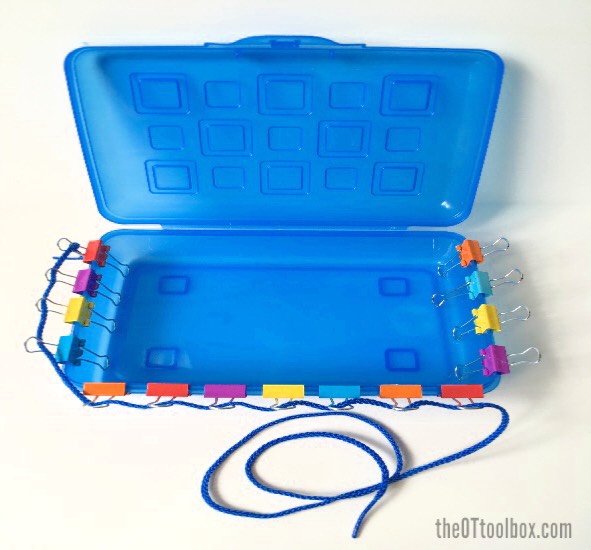
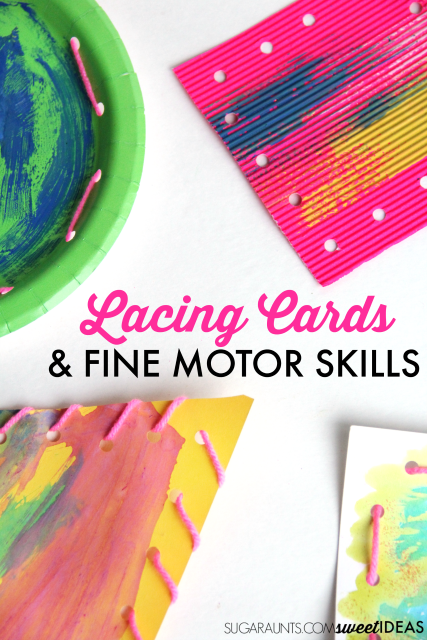
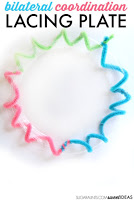

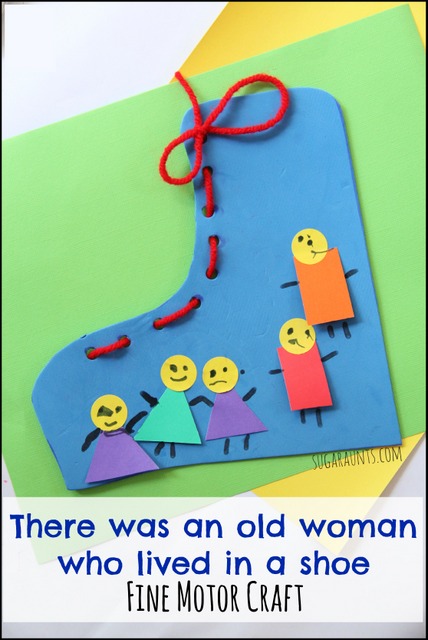
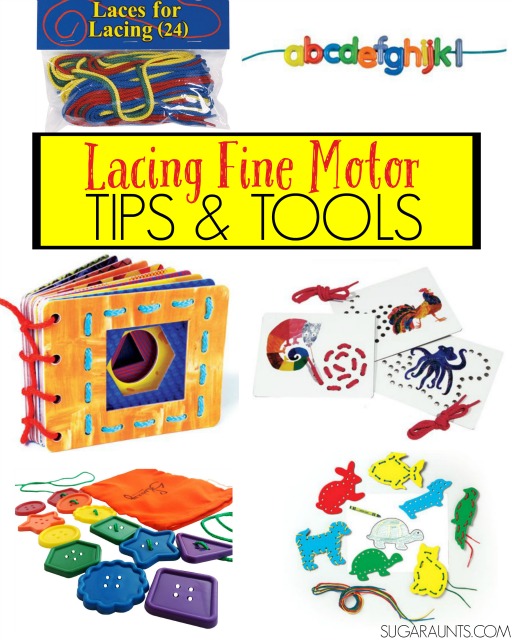
Shoe Tying Crafts
These shoe tying crafts are a fun way to work on the skills kids need to tie their shoes: fine motor skills, strength, motor planning, and precision…and they will be proud of their completed craft. Add these shoe tying crafts to your OT toolbox!

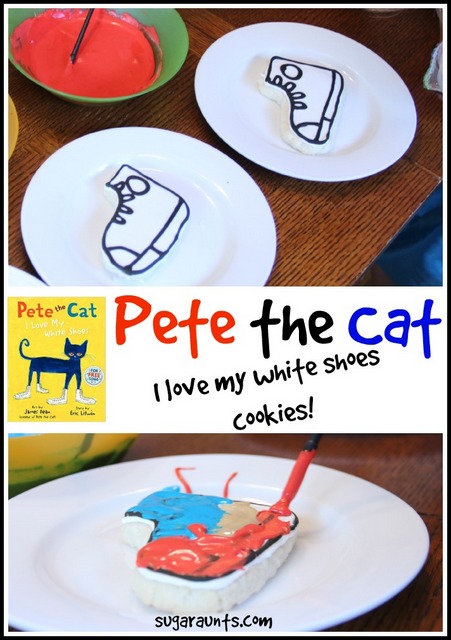
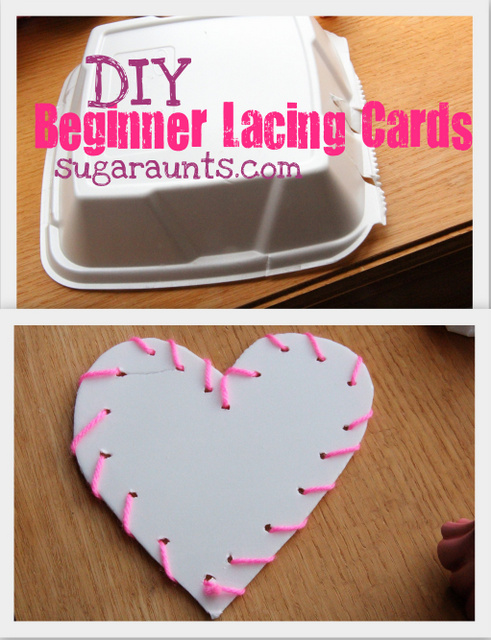
Developmental Skills for SHoe Tying
Kids need several developmental milestones in place for shoe tying! In order to tie shoes, there are many fundamental skill areas that are needed:
- Visual motor skills (eye hand coordination)
- Fine Motor skills (hand strength, pinch strength, separation of the sides of the hand, finger isolation, arch development, stabile wrist)
- Bilateral coordination
- Crossing midline
- Core strength
- Direction following
- Concentration and focus
- Visual memory
The articles below explain everything you need to know about development so that kids can independently tie their shoes.
You’ll also find resources on the underlying skills that a child needs in order to tie shoes. Check out these links- you’ll discover why shoe tying may be so tricky for some kids!

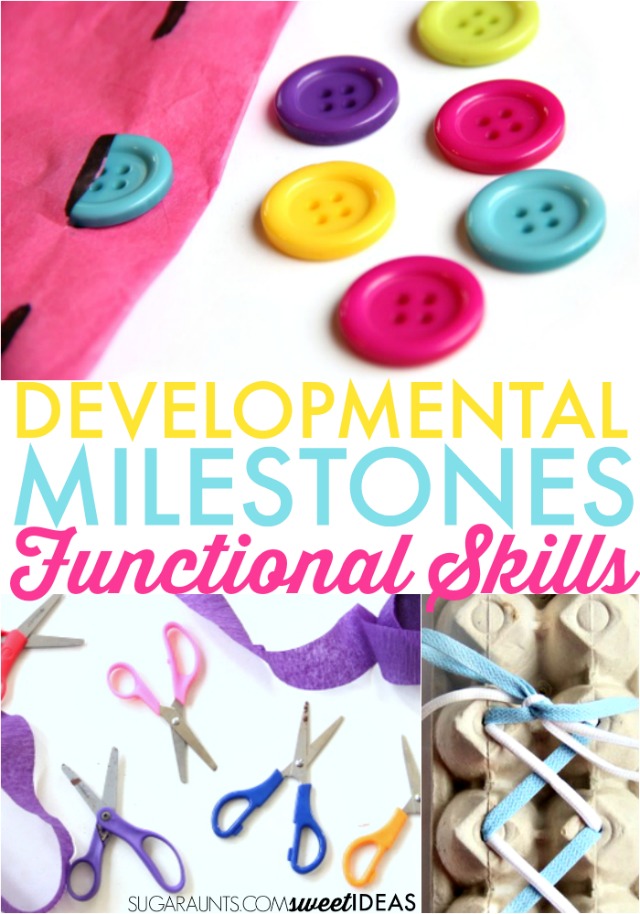
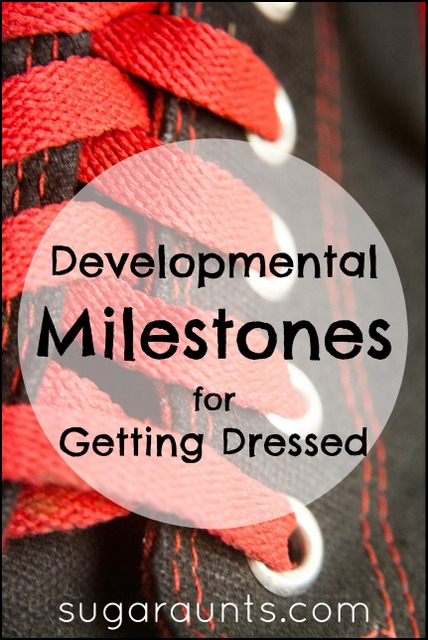
| Visual Motor and Developmental Milestones Developmental Milestones for Functional Skills Developmental Milestones for Getting Dressed |
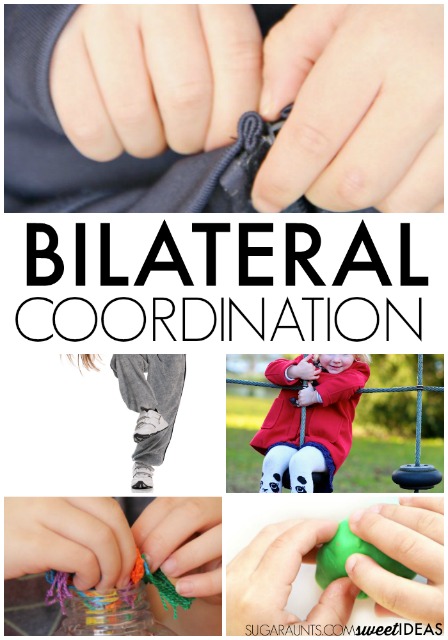

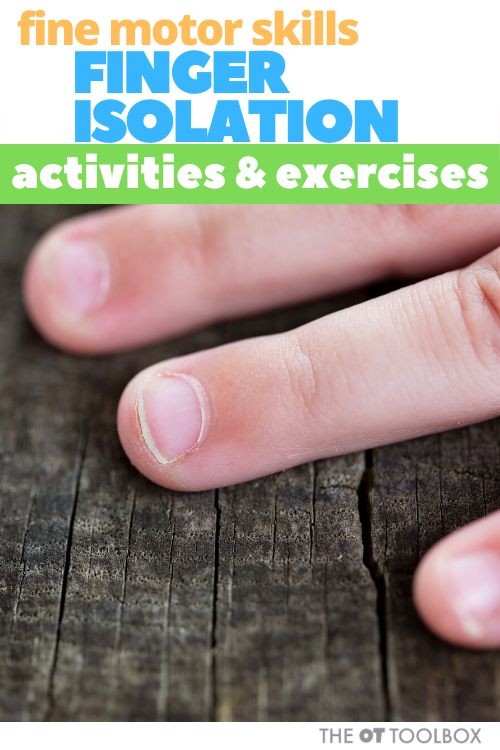
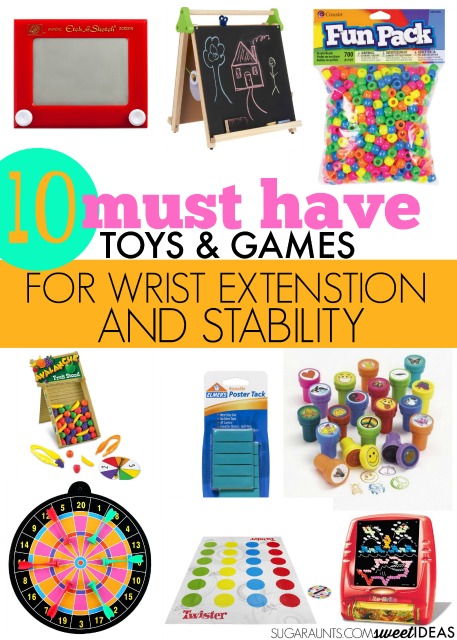

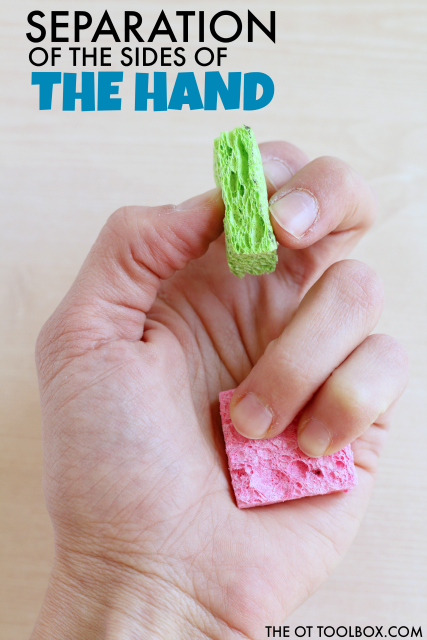
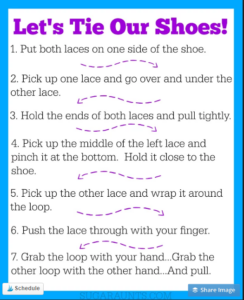
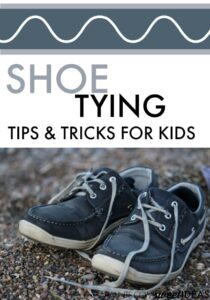
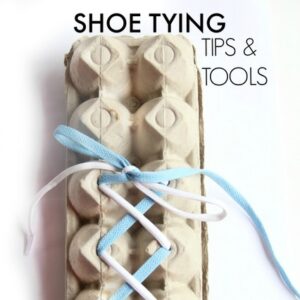

Colleen Beck, OTR/L has been an occupational therapist since 2000, working in school-based, hand therapy, outpatient peds, EI, and SNF. Colleen created The OT Toolbox to inspire therapists, teachers, and parents with easy and fun tools to help children thrive. Read her story about going from an OT making $3/hour (after paying for kids’ childcare) to a full-time OT resource creator for millions of readers. Want to collaborate? Send an email to contact@theottoolbox.com.


